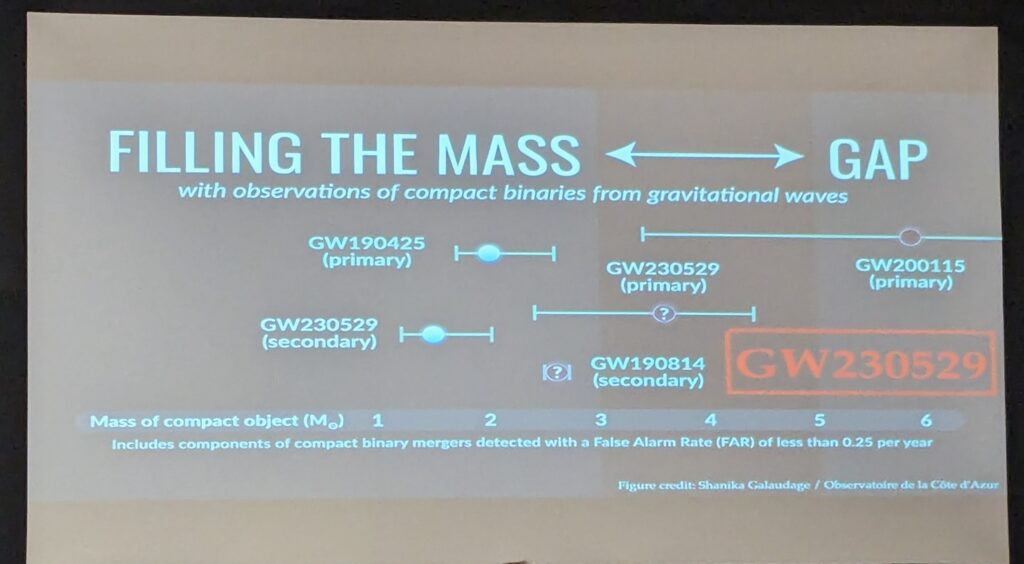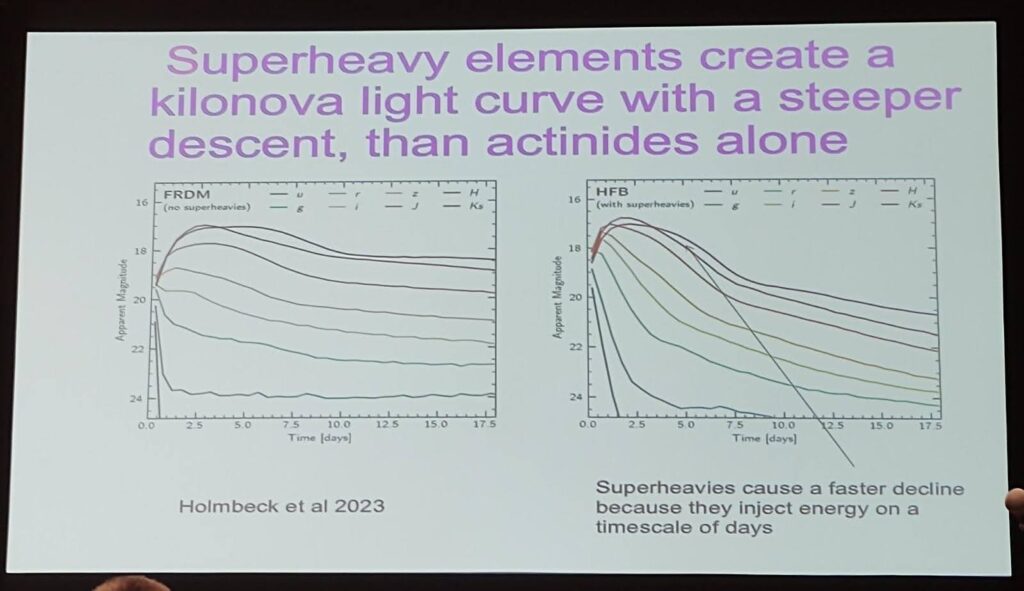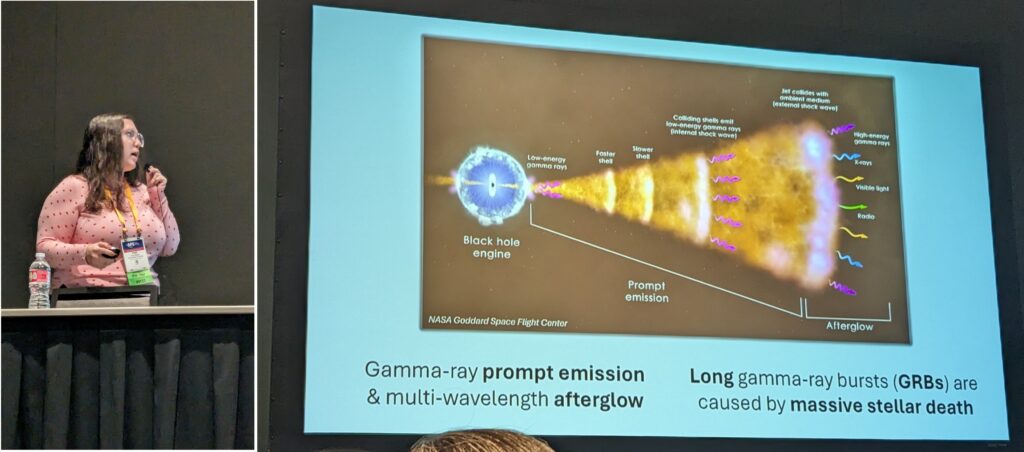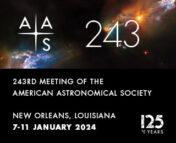Welcome to the Astrobites coverage of the 2024 April APS Meeting! We will report on highlights from each day here, from APS Plenaries to DAP (Division of Astrophysics) invited sessions to graduate student research talks. If you’d like to see more timely updates during the day, we encourage you to search the #aprilAPS hashtag on twitter. We’ll be posting once a day during the week, so be sure the visit the site often to catch all the news!
Astrophysical Results from LIGO-Virgo-KAGRA’s 4th Observing Run (by Jessie Thwaites and Huei Sears)
In a much-anticipated talk, Michael Zevin (a former Astrobiter!) presented “New Results from the LIGO-Virgo-KAGRA Gravitational-wave Observatory Network” to open this session. The LVK detectors have confirmed one of the events seen in their current observing run (O4a) to be a neutron star–black hole (NSBH) merger, which had objects that exist in the elusive lower mass gap. Essentially, there is a gap between the highest mass neutron stars and the lowest mass black holes that have been seen. There was an absence of these objects in the range of 3-5 solar masses – until now.
In a new paper (released publicly on the same day as his talk!), they identify one object that was released in realtime as a confident NSBH merger – GW230529. This event was confidently detected by the LIGO Livingston detector (unfortunately, LIGO Hanford was offline at the time), and the higher mass object in the binary was in the range of 2.5 – 4.5 solar masses, with a smaller neutron star companion.
This result leads to some interesting shifts in what we know about the population of neutron star – black hole binary systems. First, the smallest expected black hole mass in these systems has dropped from 6 solar masses, to about 3.4. Second, this allows us to update the number of these mergers we expect to see, to 30-200 mergers per year per gigaparsec cubed and also increases the rate we expect to see in this mass gap.

Following his talk, Jocelyn Read discussed how we can interpret these astrophysical signals from LVK in her talk, “Nuclear astrophysics using the LIGO-Virgo-KAGRA gravitational-wave network.” She started by discussing the way we learn about dense matter, such as any neutron star in the binary. If there is a neutron star, it can become tidally deformed, and this deformation leaves an imprint in the gravitational wave signal we see. By using the tools of nuclear physics, we can begin to understand the equation of state of these neutron stars, which in turn will help us understand the gravitational wave signal, and the binaries themselves, better.
She also discussed what we’ve begun to learn from looking at all the binary mergers we’ve seen so far (often called the “population” of these objects). We see two areas where there are very few objects observed: above 60 solar masses, and in the range of 3-5 solar masses. She also discusses how we can start to understand the formation of the heaviest elements in our universe, formed by the r-process and s-process. With the understanding of these elements through nuclear physics, we can better understand what is happening in the environment around these extreme mergers in order to produce heavy elements.
The final talk of this session was given by Derek Davis, a postdoctoral scholar at CalTech. The focus of Dr. Davis’ talk was on the astrophysical impacts of the LVK runs through O4. They first started by showing the four different “types” of gravitational waves (GWs) LVK can detect: combinations of well- or poorly-modeled wave forms with short- or long-duration waves. Dr. Davis spent the most time talking about the well-modeled, short-duration waves. These are the stereotypical LVK GWs – those assumed to be from compact binary coalescences (CBCs; i.e., BBHs, BHNSs, BNSs), and LVK (or really just LIGO), detected 81 candidates of this GW type in O4a. While their detected waveforms best match those for CBCs, they cannot be claimed as “confirmed” events until robust offline analysis. The median distances of the GWs in this O4a sample are much further than those from O3, matching expectations from the upgrades to sensitivity of LIGO since O3.
There were 1610 low-significance GW candidate events reported by LIGO in O4 as well. These are mostly classified as likely to be “terrestrial” (i.e., something on Earth caused by something that appeared like a GW event), however some had a majority likelihood of being a real candidate. This data will be open to the public soon for community analysis of this large data set. The next LVK observing run starts next week with O4b. Virgo is expected to join right at the start and KAGRA in early 2025. This run will feature the most sensitive detectors to date!
Connecting Nuclear Physics and Astrophysics (by Storm Colloms)
Friday morning’s session continued the theme of linking fields, astrophysical messengers, and astrophysical probes, this time in terms of nuclear physics – the physics of neutrons, protons, nuclei and radiation. The first talk by Dr. Gale McLaughlin asked where in the universe are the heaviest elements made? Specifically, Dr. McLaughlin investigates the r-process production of elements by rapid neutron capture, which can create uranium and thorium. These elements have atomic masses (number of protons + neutrons) around 230, depending on the number of neutrons in the nuclei. Neutron-rich heavy elements can be produced when two neutron stars or a neutron star and a black hole merge, before this material beta decays back to stable elements. These neutron-rich elements come in several categories: lanthanides, with atomic numbers between 57 and 71 which are rare-earth elements, actinides with atomic numbers between 89 and 103, and superheavies with mass numbers above 103. By looking at the light from the kilonova released from a neutron star merger, such as the kilonova from GW170817, Dr. McLaughlin showed we can find clues for which categories of these elements are produced.

The next talk was from Dr. Jorge Piekarewicz, who discussed uncovering the equation of state (EoS) for nuclear matter, which is the relationship between the pressure and density of dense nuclear matter. For a neutron star, a soft equation of state makes for a less dense, ‘fluffier’ object, whereas a stiff EoS makes for a more compact, denser object. By investigating the EoS through gravitational waves, pulsar timing, NICER observations, and with nuclear experiments in labs on Earth, Dr. Piekarewicz explained that while gravitational wave observations preferred a soft EoS, NICER, pulsar observations, and nuclear experiments on Earth preferred a stuff EoS. Because these probes vary in terms of energy density, they lead to an EoS that looks like the form of a Volkswagen Beetle!

Lastly, Dr. Erika Holmbeck furthered the discussion of r-process elements from merging neutron stars, specifically in the context of the merger GW170817. From the light detected from this merger, there is evidence for lanthanides being produced in the kilonova, but only strontium has been specifically measured. Simulations also predict that actinides were made, but many degeneracies exist in measuring the elemental abundances from kilonova light curves, motivating Dr. Holmbeck to switch to another probe: stars which have been enriched by gas from these kilonovae. Because throughout the evolution of the universe the gas from kilonovae goes on to form new stars enriched with heavy elements produced in the explosion, these enriched stars become a probe for understanding what elements were produced in kilonovae. Dr. Holmbeck found using these observations that fission of heavy elements in the kilonova is crucial to explain the elemental abundances we detect in these stars.
The Spins of Stellar-Mass Black Holes (by Storm Colloms)
Black holes are some of the most simple objects in the universe – they only have three properties – mass, spin, and charge (which is almost always zero). The first speaker in this session, Monica Gallegos-Garcia, a graduate student at Northwestern University, tells us how the spin of a stellar-mass black hole (a black hole with the mass from the same mass as our sun up to around 100 times more massive) can be impacted before black hole formation, during and after. Before a massive star turns into a black hole, the star’s spin depends on the angular momentum transfer between a star’s core and its surface, as well as binary interactions with another star that could spin up the star. The final core spin of a massive star could be important for the spin of the black hole it creates, but these factors vary the resulting black hole between a non-spinning black hole to a maximally spinning black hole. Secondly, we have to know whether the rotation of the core is preserved during a supernova. This also depends on many factors, including how and if an accretion disk and jets are formed around the newly born black hole. Lastly, the black hole can be further changed by its interactions with another star in the system, but there are yet again unknowns in how much the black hole is allowed to change during this final stage. Gallegos-Garcia highlights the power of population synthesis – the simulations of many black hole generating systems – to be able to put efforts across many subfields together to better understand the spins of black holes, and explain what we see with black hole observations.
Next, Dr. Salvatore Vitale of MIT tells us about gravitational wave observations of black hole spin. In the past, Dr. Vitale explains, we used to think we could distinguish between a subpopulation of black holes with aligned spins, corresponding to black hole binaries formed from binary stars, and black holes with a uniform distribution of spins, corresponding to binaries formed through dynamical encounters, after around 80 gravitational wave observations. We have over 80 observations now, but we haven’t been able to make this distinction, so what’s happened? It turns out that most of the gravitational wave observations of black hole spin sit in the sweet spot where it is hardest to measure, and we come away with very large uncertainties on these spin measurements. Furthermore, the models we choose to describe black hole spins play a huge role in the results we measure. As it turns out, these uncertainties and model choice will still prove a problem when we have 1500 gravitational wave observations, the forecast for the late 2020s.
However, we also have another probe of black hole spin, which we can measure from X-ray binaries. Paul Draghis, a graduate student at the University of Michigan, introduces the audience into how these measurements are made and what we can learn. The X-ray continuum of the accretion disk can tell us about the dynamics of the system – high spin will lead to a brighter, closer, and hotter disk, while a higher distance will lead to a lower flux. Picking out the impact of the spin on these measurements can be hard as it requires assumptions about the mass, distance and inclination of the disk. On the other hand, we can measure the reflection of radiation off of the disk, but this requires a complete characterization of the continuum behind it. Fortunately, we still have measurements of black hole spin from X-ray binaries. But they are suspiciously different from what we see with gravitational wave measurements. Looking for any measurement biases in measuring X-ray binary spins doesn’t reveal any clues, Draghis says more work is required to understand what in the universe is happening with black hole spin.
Highlighting the research of Astrobites authors
We also want to highlight the research our Astrobites authors are doing and presenting at APS April!
Transients and Interacting Binaries (by Jessie Thwaites)
Astrobites author Huei Sears gave a talk in this session on her research, “Late-Time Observations of the Ultraluminous GRB 221009A.” This extreme gamma-ray burst (GRB) has been the focus of multiple Astrobites (see here, here, and here for some of our coverage), breaking the record for the brightest GRB ever observed. It is a long GRB, which means it likely came from the supernova explosion of a massive star.
There are two parts of the emission for long GRBs – prompt emission (happening right after the supernova explosion itself) and afterglow emission, which can be seen for days, months, even years after the burst, and this afterglow is the focus of Huei’s talk. She and her team have now observed this GRB afterglow out to 345 days after the explosion itself with JWST and the Hubble Space Telescope (HST). She showed a light curve from the afterglow of this GRB, as well as a spectral energy distribution (or SED) for this burst. There is a blue feature in the spectral energy distribution that can’t be explained by the afterglow alone, which could point to a star cluster in the vicinity of this GRB.

Featured Image Credit: NASA, ESA, CSA/Joseph DePasquale (STScI), Anton M. Koekemoer (STScI)
Edited by: Storm Colloms, Huei Sears, Jessie Thwaites



